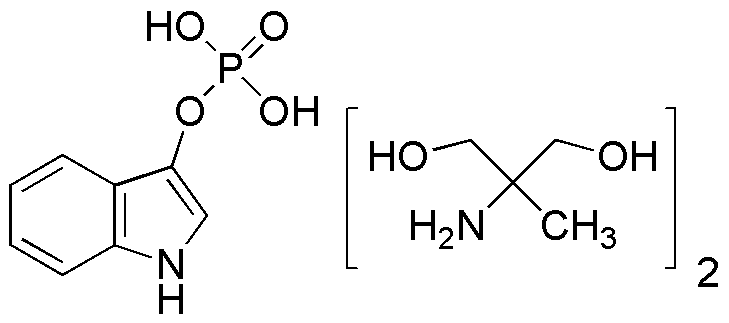3-Indoxyl phosphate-bis(2-amino-2-methyl-1,3-propanediol) salt is widely utilized in research focused on:
- Biochemical Assays: This compound serves as a substrate in enzyme assays, particularly in studies involving phosphatases, enabling researchers to measure enzyme activity effectively.
- Cell Culture Applications: It is used in cell culture media to support the growth of specific cell lines, enhancing cellular metabolism and viability in laboratory settings.
- Pharmaceutical Development: The compound plays a role in drug formulation, particularly in the development of therapeutic agents targeting various diseases, due to its ability to enhance solubility and bioavailability.
- Diagnostic Tools: It is incorporated into diagnostic kits for detecting specific biomarkers, aiding in the early diagnosis of diseases through colorimetric changes.
- Research on Signal Transduction: This chemical is utilized in studies examining cellular signaling pathways, helping scientists understand complex biological processes and disease mechanisms.
General Information
Properties
Safety and Regulations
Applications
3-Indoxyl phosphate-bis(2-amino-2-methyl-1,3-propanediol) salt is widely utilized in research focused on:
- Biochemical Assays: This compound serves as a substrate in enzyme assays, particularly in studies involving phosphatases, enabling researchers to measure enzyme activity effectively.
- Cell Culture Applications: It is used in cell culture media to support the growth of specific cell lines, enhancing cellular metabolism and viability in laboratory settings.
- Pharmaceutical Development: The compound plays a role in drug formulation, particularly in the development of therapeutic agents targeting various diseases, due to its ability to enhance solubility and bioavailability.
- Diagnostic Tools: It is incorporated into diagnostic kits for detecting specific biomarkers, aiding in the early diagnosis of diseases through colorimetric changes.
- Research on Signal Transduction: This chemical is utilized in studies examining cellular signaling pathways, helping scientists understand complex biological processes and disease mechanisms.
Documents
Safety Data Sheets (SDS)
The SDS provides comprehensive safety information on handling, storage, and disposal of the product.
Product Specification (PS)
The PS provides a comprehensive breakdown of the product’s properties, including chemical composition, physical state, purity, and storage requirements. It also details acceptable quality ranges and the product's intended applications.
Certificates of Analysis (COA)
Search for Certificates of Analysis (COA) by entering the products Lot Number. Lot and Batch Numbers can be found on a product’s label following the words ‘Lot’ or ‘Batch’.
*Catalog Number
*Lot Number
Certificates Of Origin (COO)
This COO confirms the country where the product was manufactured, and also details the materials and components used in it and whether it is derived from natural, synthetic, or other specific sources. This certificate may be required for customs, trade, and regulatory compliance.
*Catalog Number
*Lot Number
Safety Data Sheets (SDS)
The SDS provides comprehensive safety information on handling, storage, and disposal of the product.
DownloadProduct Specification (PS)
The PS provides a comprehensive breakdown of the product’s properties, including chemical composition, physical state, purity, and storage requirements. It also details acceptable quality ranges and the product's intended applications.
DownloadCertificates of Analysis (COA)
Search for Certificates of Analysis (COA) by entering the products Lot Number. Lot and Batch Numbers can be found on a product’s label following the words ‘Lot’ or ‘Batch’.
*Catalog Number
*Lot Number
Certificates Of Origin (COO)
This COO confirms the country where the product was manufactured, and also details the materials and components used in it and whether it is derived from natural, synthetic, or other specific sources. This certificate may be required for customs, trade, and regulatory compliance.


